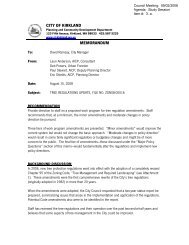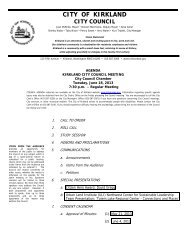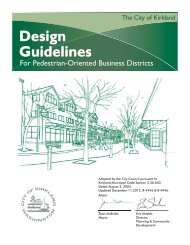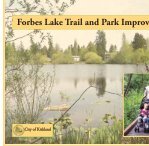Low Impact Development (LID) Feasibility Study - City of Kirkland
Low Impact Development (LID) Feasibility Study - City of Kirkland
Low Impact Development (LID) Feasibility Study - City of Kirkland
Create successful ePaper yourself
Turn your PDF publications into a flip-book with our unique Google optimized e-Paper software.
IntroductionWashington’s neighbors to the south are also finding ways to pair <strong>LID</strong> with CIP projects. The San Francisco PublicUtilities Commission (SFPUC) expects to craft an evaluation process to review capital improvement projects for floodmitigation to determine the feasibility <strong>of</strong> <strong>LID</strong> approaches as part <strong>of</strong> its 5-year CIP program (SFPUC, 2007). Portland,Oregon has taken an even more comprehensive approach to <strong>LID</strong> by adopting a “Green Streets Policy” in April, 2007that “ directs <strong>City</strong> Bureaus and agencies to cooperatively plan and implement Green Streets as an integral part <strong>of</strong> the<strong>City</strong>’s maintenance, installation, and improvement programs for its infrastructure located in the public right <strong>of</strong> way,and to integrate the Green Street Policy into the <strong>City</strong>’s Comprehensive Plan, Transportation System Plan, and <strong>City</strong>wideSystems Plan” (<strong>City</strong> <strong>of</strong> Portland, Auditor’s Office, 2007) In passing this resolution, the Portland <strong>City</strong> Council recognizedthat “60 to 70 % <strong>of</strong> Portland stormwater is attributable to paved streets and run<strong>of</strong>f directed from private propertyand concentrated in the public right <strong>of</strong> way” and streets with <strong>LID</strong> elements are “an effective way to help managestormwater volume and water quality”. Portland’s Green Streets Policy emphasizes the need for “identifying andevaluating opportunities to partner” to coordinate land use planning and capital improvement projects as well as toencourage cross-bureau collaboration in planning (<strong>City</strong> <strong>of</strong> Portland, Auditor’s Office, 2007).In addition to the inclusion <strong>of</strong> <strong>LID</strong> in CIP projects, a number <strong>of</strong> cities in Washington, including <strong>Kirkland</strong>, have adoptedordinances and/or revised their comprehensive plans to promote and/or require <strong>LID</strong> in private development (<strong>City</strong><strong>of</strong> <strong>Kirkland</strong>, 2007, see Appendix A) (PSAT, 2000). For example, the <strong>City</strong> <strong>of</strong> Issaquah revised its municipal code toallow “deviations from stormwater design standards to achieve ‘low impervious surface development.’” Issaquah’smunicipal code also provides up to a 50 percent reduction in stormwater utility fees for a project that infiltrates 100percent <strong>of</strong> its stormwater. Employing more <strong>of</strong> an encouragement approach, the cities <strong>of</strong> Lacey and Tumwater haveadopted ordinances which promote voluntary preservation <strong>of</strong> 60-65 percent <strong>of</strong> natural habitat or forested areas indevelopments. In order to achieve goals <strong>of</strong> “zero effect drainage,” the <strong>City</strong> <strong>of</strong> Lacey will “grant administrative variancesfrom traditional standards to achieve the ordinance’s goal,” including “constructing narrower roads without curb andgutter” and “using pervious paving systems.” Island County adopted a stormwater ordinance that permits developersto include <strong>LID</strong> in their projects using design standards based on <strong>Low</strong> <strong>Impact</strong> <strong>Development</strong> Design Strategies—AnIntegrated Design Approach, Prince Georges County, Maryland, 2000. While the <strong>City</strong> <strong>of</strong> Issaquah <strong>of</strong>fers incentives for<strong>LID</strong> and Lacey and Tumwater encourage the voluntary inclusion <strong>of</strong> <strong>LID</strong> in projects, the <strong>City</strong> <strong>of</strong> Olympia requires <strong>LID</strong> inprojects within a specific drainage basin. Some <strong>of</strong> Olympia’s <strong>LID</strong> regulations include tree protection and replacementrequirements, impervious surface limits, minimum tree density requirements, allowances for increased sidewalkplanter widths (up to 25’), and matching post-development stormwater discharge rates to pre-development dischargerates (PSAT, 2000).The examples <strong>of</strong> <strong>LID</strong> incorporated both in CIP and in private development projects suggest that this approach tostormwater management is gaining greater acceptance and implementation. The next section provides more detailabout a number <strong>of</strong> specific elements that comprise <strong>LID</strong>.<strong>LID</strong> in commercial areas<strong>LID</strong> in residential areasVine Street, Seattle (before)Highpoint, Seattle (before)Vine Street, Seattle • Cistern Steps (after)Highpoint Redevelopment(Bioretention swales & porouspavement) (after)Vine Street, Seattle • Cistern Steps (after)Highpoint Redevelopment(Bioretention swales) (after)c<strong>City</strong> <strong>of</strong> <strong>Kirkland</strong> <strong>LID</strong> <strong>Feasibility</strong> <strong>Study</strong> for CIP Projects | SvR No. 07016 | December 21, 2007
















